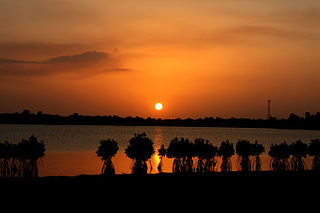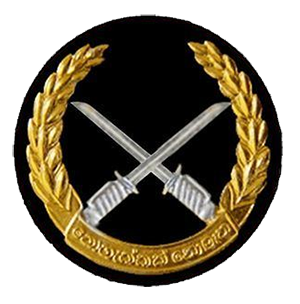
The Sri Lankan Civil War was a civil war fought in Sri Lanka from 1983 to 2009. Beginning on 23 July 1983, it was an intermittent insurgency against the government by the Liberation Tigers of Tamil Eelam led by Velupillai Prabhakaran. The LTTE fought to create an independent Tamil state called Tamil Eelam in the north-east of the island, due to the continuous discrimination and violent persecution against Sri Lankan Tamils by the Sinhalese-dominated Sri Lanka government.

The Special Task Force (STF) (Sinhala: විශේෂ කාර්ය බලකාය Visesha Karya Balakaya; Tamil: சிறப்பு அதிரடிப் படை) is an elite police tactical unit of the Sri Lanka Police specialising in clandestine and covert operations, combat and patrolling in urban areas, combat search and rescue, counterinsurgency and counterterrorism operations, crowd control, executive protection, forward observer, hostage rescue, indirect fire, irregular warfare, jungle and mountain warfare, parachuting, psychological warfare, search and rescue people who are in distress or imminent danger from disaster. serving high-risk arrest and search warrants, special reconnaissance, support military operations, tactical emergency medical, tracking, and unconventional tactics. It was formed in 1983 not as a military force, but rather as a highly specialised armed police unit.

The Tamil National Alliance is a political alliance in Sri Lanka that represents the country's Sri Lankan Tamil minority. It was formed in October 2001 by a group of moderate Tamil nationalist parties and former militant groups. The alliance originally supported self-determination in an autonomous state for the island's Tamils. It supported negotiations with the rebel Liberation Tigers of Tamil Eelam (LTTE) to resolve the civil war in Sri Lanka. The TNA was considered a political proxy of the LTTE which selected some of its candidates even though its leadership maintains it never supported the LTTE and merely negotiated with the LTTE just as the Government did.

The Eastern Province is one of the nine provinces of Sri Lanka, the first level administrative division of the country. The provinces have existed since the 19th century but did not have any legal status until 1987 when the 13th Amendment to the Constitution of Sri Lanka established provincial councils. Between 1988 and 2006 the province was temporarily merged with the Northern Province to form the North Eastern Province. The capital of the province is Trincomalee. Kalmunai is the largest and most populous city of Eastern Province.
Vinayagamoorthy Muralitharan is a Sri Lankan politician and former militant. Formerly a fighter for the Tamil separatist group, the Liberation Tigers of Tamil Eelam (LTTE), for over 20 years, Muralitharan later rose to prominence after defecting from the LTTE and forming the Tamil Makkal Viduthalai Pulikal (TMVP), a breakaway faction of the LTTE.
The Mavil Aru is a waterway that supplies water to some regions of eastern Sri Lanka. The closing of the sluice gates is considered to be the official beginning of the Eelam War IV although violence including skirmishes and bombings happened before.

The Vaharai bombing is a disputed event in the Sri Lankan civil war. It occurred on November 7, 2006 when, according to survivors of the incident interviewed by Reuters, the Liberation Tigers of Tamil Eelam fired artillery at Sri Lankan military personnel from near a school where minority Sri Lankan Tamil refugees displaced by the current phase of the Sri Lankan civil war had taken shelter. The Sri Lankan Army returned fire and around 45 civilians were killed. Over 100 were injured and admitted to the local hospitals. However, people who were interviewed by Human Rights Watch claimed that the LTTE did not fire artillery. Further, the rebel LTTE denies firing artillery from close to the school. The incident occurred at around 11.35 a.m close to Kathiraveli, a coastal village in Vaharai peninsula of the Batticaloa district in eastern Sri Lanka.
The Pottuvil Massacre was the killing of 10 Muslim labourers who had gone to repair the bund of Rattal Tank in Pottuvil in the southern part of the Ampara District on 17 September 2006. The victims were all men aged between 18–35 whose bodies were found hacked to death the next morning. The massacre was widely believed to have been carried out by the Special Task Force (STF).
Operation Definite Victory was a military operation launched by Sri Lankan Special Task Force commandos on January 4, 2007 to liberate the Kanchikudichcharu and Thoppigala regions of the Ampara District of Sri Lanka from the LTTE. The army had accused the LTTE of carrying out the child abductions in Bakmitiyawa and Ampara, including the abduction of two teachers and 23 Tamil children in December by LTTE cadres when they were returning from extra classes to their homes.

The Commando Regiment is the commando formation of the Sri Lanka Army. The unit specializes in various roles including hostage rescue, counter-terrorism, unconventional warfare, special reconnaissance, counter-insurgency, and personnel recovery. It was formed in 1980 and is based in Ganemulla, a suburb of Colombo.
Eelam War III is the name given to the third phase of armed conflict between the Sri Lankan military and the separatist Liberation Tigers of Tamil Eelam (LTTE).

Eelam War IV is the name given to the fourth phase of armed conflict between the Sri Lankan military and the separatist Liberation Tigers of Tamil Eelam (LTTE). Renewed hostilities began on the 26 July 2006, when Sri Lanka Air Force fighter jets bombed several LTTE camps around Mavil Aru anicut. The government's casus belli was that the LTTE had cut off the water supply to surrounding paddy fields in the area. Shutting down the sluice gates of the Mavil Aru on July 21 depriving the water to over 15,000 people - Sinhalese and Muslim settlers under Sri Lankan state-sponsored colonisation schemes in Trincomalee district. They were denied of water for drinking and also cultivating over 30,000 acres of paddy and other crops. The fighting resumed after a four-year ceasefire between the Government of Sri Lanka (GoSL) and LTTE. Continued fighting led to several territorial gains for the Sri Lankan Army, including the capture of Sampur, Vakarai and other parts of the east. The war took on an added dimension when the LTTE Air Tigers bombed Katunayake airbase on March 26, 2007, the first rebel air attack without external assistance in history.
The Battle of Thoppigala took place between the Sri Lanka Army and the Liberation Tigers of Tamil Eelam (LTTE) fought during a period of the first half of 2007 over control of the LTTE-dominated peak of Thoppigala, located 40 km northwest of Batticaloa, in eastern Sri Lanka.
The Battle of Jaffna was fought from October to December 1995 for the city of Jaffna.
The Northern Theatre of Eelam War IV refers to the fighting that took place in the northern province of Sri Lanka between July 2006 and May 18, 2009.
The Battle of Sampur was fought in 2006 for the town of Sampur.
Operation Jayasikurui, was a Sri Lankan military operation launched on 13 May 1997, it lasted until 1999, when it was called off. The operation was initially launched for 6 months but cancelled after 18 months as Sri Lankan government faced huge loss. It was the largest military operation undertaken by the armed forces at the time.

The Battle of Kilinochchi was a land battle fought between the Sri Lankan Military and the Liberation Tigers of Tamil Eelam (LTTE) for control of the town of Kilinochchi in the Northern Theatre of Eelam War IV during the Sri Lankan civil war between November 2008 and January 2009. The town of Kilinochchi was the administrative center and de facto capital of the LTTE's proposed state of Tamil Eelam.








